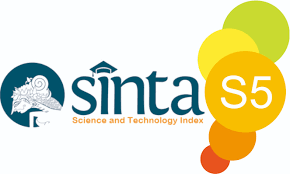ANALISIS LOWONGAN PEKERJAAN DI BIDANG TEKNOLOGI INFORMASI BERDASARKAN LOKASI MENGGUNAKAN TEKNIK KLASTERING K – MEANS
DOI:
https://doi.org/10.51977/jti.v7i1.2020Keywords:
K-Means, job vacancies, clustering, Davies-Bouldin Index, location distributionAbstract
This study analyzes job vacancy distribution in the Technology Information sector based on location using the K-Means clustering technique. In the current era of Industry 4.0, job seekers and employers face challenges with data overload and time-consuming recruitment processes. Identifying hidden patterns in job vacancy data is crucial to understanding the concentration of job opportunities across regions. The methodology involves data preprocessing, including data cleaning, transformation, and normalization, followed by clustering using K-Means and evaluation with the Davies-Bouldin Index (DBI) to determine optimal clustering. The results reveal that clustering with 6 groups provides the most meaningful separation of job vacancies based on location and category, with a significant dominance of one cluster. The findings suggest that more detailed analysis of smaller clusters could uncover niche opportunities. This approach can assist policymakers and job seekers in making more informed decisions regarding career opportunities.
References
Agustiana, S. (2010). Hubungan minat dan motivasi menjadi perawat dengan prestasi belajar (pada mahasiswa program studi D III Keperawatan di Sekolah Tinggi Ilmu Kesehatan Hutama Abdi Husada Tulungagung) (Doctoral dissertation, UNS (Sebelas Maret University)).
Anggita, A. D. (2018). Pengaruh Motivasi dan Disiplin Kerja Terhadap Kinerja Karyawan (Studi Karyawan pada PT. Safari Junie Textindo Boyolali) (Doctoral dissertation, Universitas Muhammadiyah Surakarta).
Ciptaningtyas, G. (2019). Pengaruh Aktivis Organisasi Intra Kampus Terhadap Hasil Belajar Mahasiswa Jurusan Pendidikan Ilmu Pengetahuan Sosial Uin Syarif Hidayatullah Jakarta (Bachelor's Thesis, Jakarta: Fitk Uin Syarif Hidayatullah Jakarta).
Firdaus, N., & Imallah, R. N. (2017). Hubungan Motivasi Belajar Dengan Prestasi Belajar Mahasiswa Semester Ii Program Studi Ilmu Keperawatan Universitas ‘Aisyiyah Yogyakarta (Doctoral Dissertation, Universitas' Aisyiyah Yogyakarta).
Haq, A. (2018). Motivasi belajar dalam meraih prestasi. Jurnal vicratina, 3(1), 193-214.
Hasyyati, E. S. (2017). Pengaruh Konsep Diri Dan Minat Belajar Terhadap Hasil Belajar Pada Siswa Di Smk Al-Wasliyah (Doctoral Dissertation, Universitas Negeri Jakarta).
Hidayati, S. R., Reliani, S. K., & Nasrullah, D. (2016). Hubungan Motivasi Belajar Dengan Prestasi Belajar Pada Mahasiswa Yang Berorganisasi Di Fakultas Ilmukesehatan Universitas Muhammadiyah Surabaya Tahun Akademik 2014-2015 (Doctoral Dissertation, Universitas Muhammadiyah Surabaya).
Junaedi, I. (2019). Proses Pembelajaran Yang Efektif. Jisamar (Journal Of Information System, Applied, Management, Accounting And Research), 3(2), 19-25.
Khodijah, N. 2014. Psikologi Pendidikan. Jakarta: Rajawali Pers.
Komalasari, H., & Irawan, A. T. (2018). Hubungan Motivasi Menjadi Perawat Dengan Prestasi Akademik Mahasiswa Akper Ypib Majalengka Tahun 2017. Jurnal Keperawatan Dan Kesehatan Medisina Akper Ypib, 1-10.
Maghsoudi, A., & Mohammadi, Z. (2016). The Study Of Prevalence Of Chronic Diseases And Its Association With Quality Of Life In The Elderly Of Ewaz (South Of Fars Province), 2014. Navid No, 18(61), 35-42.
Mulyaningsih, I. E. (2014). Pengaruh Interaksi Sosial Keluarga, Motivasi Belajar, Dan Kemandirian Belajar Terhadap Prestasi Belajar. Jurnal Pendidikan Dan Kebudayaan, 20(4), 441-451.
Mustofa, W., & Setyaningsih, N. (2014). Pengaruh Suasana Belajar Dan Motivasi Belajar Terhadap Intensitas Belajar Serta Dampaknya Pada Prestasi Belajar Matematika (Pada Siswa Kelas VIII Semester Gasal SMP N 1 Trangkil Tahun Ajaran 2014/2015) (Doctoral dissertation, Universitas Muhammadiyah Surakarta).
Sunarsih, T. (2010). Hubungan Antara Motivasi Belajar, Kemandirian Belajar Dan Bimbingan Akademik Terhadap Prestasi Belajar Mahasiswa Di Stikes A. Yani Yogyakarta (Doctoral Dissertation, Uns (Sebelas Maret University)).
Suprapto, S., Malik, A. A., & Yuriatson, Y. (2019). Relationship Of Motivation To Be A Nurse With Learning Achievement. Jurnal Ilmiah Kesehatan Sandi Husada, 8(2), 39-43.
Wahyuni, S. (2022). Hubungan Motivasi Menjadi Perawat Dengan Prestasi Akademik Mahasiswa Akper Ypib Majalengka Tahun 2021. Medisina, 8(2), 22-30.
Downloads
Published
Issue
Section
License
Pemberitahuan Hak Cipta
Usulan kebijakan untuk jurnal yang menawarkan akses terbuka Syarat yang dibutuhkan penulis adalah sebagai berikut:
1. Penulis memegang hak cipta dan memberikan jurnal hak penerbitan pertama secara bersamaan di bawah lisensi di bawah Creative Commons Attribution-ShareAlike 4.0 International (CC BY-SA 4.0), yang mengizinkan orang lain untuk menyalin dan mendistribusikan ulang materi ini dalam bentuk atau format apa pun termasuk menyusun, memodifikasi, dan membuat turunan materi ini untuk tujuan apa pun, termasuk tujuan komersial.
2. Penulis dapat membuat pengaturan kontrak terpisah untuk distribusi non-eksklusif dari versi dekaden publikasi jurnal (misalnya mempostingnya ke repositori institusional atau menerbitkannya dalam sebuah buku), dengan mengakui publikasi aslinya di jurnal ini.
3. Penulis diizinkan dan didorong untuk memposting artikel secara online (misalnya di repositori institusional atau di situs web mereka) seperti pada Garuda, Academia, researchgate atau repository lainnya sebelum dan selama proses pengiriman, karena dapat menghasilkan pertukaran yang produktif dan kutipan artikel yang diterbitkan lebih awal dan lebih maju (periksa: Efek Akses Terbuka)

This work is licensed under a Creative Commons Attribution-ShareAlike 4.0 International License.










